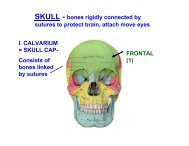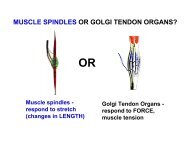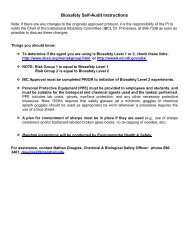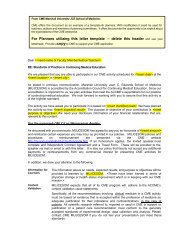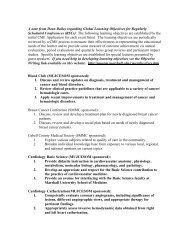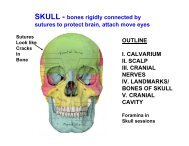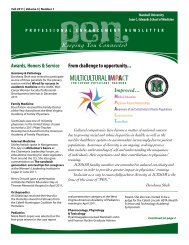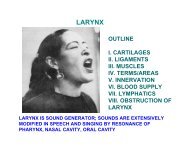FA 5 Progress Report WV-INBRE - Joan C. Edwards School of ...
FA 5 Progress Report WV-INBRE - Joan C. Edwards School of ...
FA 5 Progress Report WV-INBRE - Joan C. Edwards School of ...
- No tags were found...
Create successful ePaper yourself
Turn your PDF publications into a flip-book with our unique Google optimized e-Paper software.
Program Director/Principal Investigator (Last, First, Middle): Rankin, Gary O 45SEX STEROID HORMONES AND EPIGENETICS IN MENINGIOMAS (0038)TYPE: Research Subproject%IDeA $: 5.000% IDeA $: 174,407INVESTIGATOR, DEGREEHankins, Gerald PHDDEPARTMENTBiologyNON-HOST INSTITUTION: STATE,COUNTRYWest Virginia State University, Wv UsaTotal # human subjects expected for entire study: 0Total # human subjects enrolled to date: 0SUBPROJECT DESCRIPTIONMeningiomas comprine approximately 30% <strong>of</strong> primary central nervous system tumors in the United States,however their pathobiology is poorly understood. Over 90% <strong>of</strong> meningiomas are benign while 5% areatypical and 3-5% are malignant. Complete surgical resection is the treatment <strong>of</strong> choice for benignmeningiomas. Surgical resection is <strong>of</strong>ten difficult since approximately one-half <strong>of</strong> benign intracranialmeningiomas arise in the skull base. For skull base meningiomas the surgical complication rate can be ashigh as 30 to 40% even in expert hands. The female to male incidence ratio in adults is 2:1 for intracranialtumors and 10:1 for spinal tumors, while no such sex difference exists for meningiomas in children.Therefore, the female sex steroid hormones progesterone and -estradiol are suspected factors inmeningioma tumorigenesis. However, no mechanisms have been demonstrated for female sex hormonesinmeningioma formation or progression. We recently reported evidence that a steroid responsive gene,deleted in liver cancer-1 (DLC1), may function as a tumor suppressor in meningiomas. Our microarray dataindicate that a number <strong>of</strong> steroid responsive genes are differentially expressed between meningiomas andnormal meninges. We also found that steroid hormones and their antagonists can alter the growth <strong>of</strong>meningioma cells and that histone deacetylase inhibitors induce a decrease <strong>of</strong> meningioma cell growth inculture. Our long-term goal is to develop strategies to prevent or slow meningioma tumor growth that canserve as alternatives or adjuncts to surgery. The central hypotheses <strong>of</strong> this study are 1) that meningiomatumorigenesis is driven in part by actions <strong>of</strong> female steroid hormones and 2) that the tumorrigenesis may bemediated in part by progesterone and estrogen receptor containing chromatin-modifying complexes. Wepropose to test our hypothesis by pursuing the following three specific aims:1) To treat meningioma cells with progesterone or 17β-estradiol and assess the expression <strong>of</strong> severalgenes that are differentially regulated between meningiomas and normal meninges.2) To evaluate the effects <strong>of</strong> inhibitors <strong>of</strong> DNA methylation or histone de-acetylation on the growth <strong>of</strong>meningioma cells in vitro and on expression <strong>of</strong> genes that are differentially expressed betweenmeningiomas and normal meninges.3) To determine whether the promoters <strong>of</strong> the differentially regulated genes in specific aim 1 and 2 arebound by progesterone receptor, estrogen receptor, ETS2, or the histone acetyltransferase p300.1) To treat meningioma cells with progesterone or 17 -estradiol and assess the expression <strong>of</strong> severalgenes that are differentially regulated between meningiomas and normal meninges.2) To evaluate the effects <strong>of</strong> inhibitors <strong>of</strong> DNA methylation or histone de-acetylation on the growth <strong>of</strong>meningioma cells in vitro and on expression <strong>of</strong> genes that are differentially expressed betweenmeningiomas and normal meninges.3) To determine whether the promoters <strong>of</strong> the differentially regulated genes in specific aim 1 and 2 arebound by progesterone receptor, estrogen receptor, ETS2, or the histone acetyltransferase p300.SUBPROJECT PROGRESSDuring the past year we have focused on specific aims 1 and 2.One graduate student and an undergraduate student have focused on fibroblast growth factorsPHS 2590 (Rev. 06/09)Continuation Format Page



